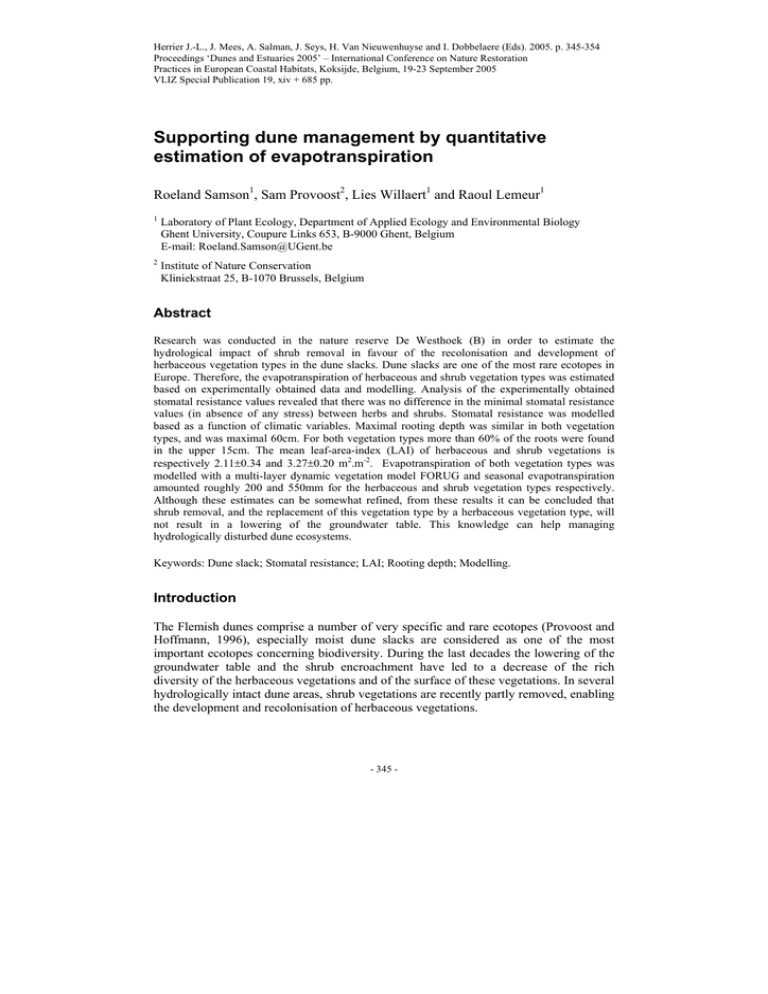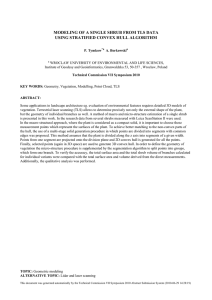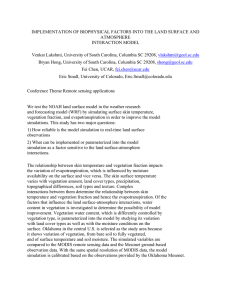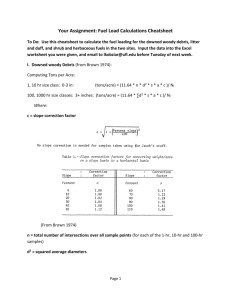Document 12095718
advertisement

Herrier J.-L., J. Mees, A. Salman, J. Seys, H. Van Nieuwenhuyse and I. Dobbelaere (Eds). 2005. p. 345-354 Proceedings ‘Dunes and Estuaries 2005’ – International Conference on Nature Restoration Practices in European Coastal Habitats, Koksijde, Belgium, 19-23 September 2005 VLIZ Special Publication 19, xiv + 685 pp. Supporting dune management by quantitative estimation of evapotranspiration Roeland Samson1, Sam Provoost2, Lies Willaert1 and Raoul Lemeur1 1 Laboratory of Plant Ecology, Department of Applied Ecology and Environmental Biology Ghent University, Coupure Links 653, B-9000 Ghent, Belgium E-mail: Roeland.Samson@UGent.be 2 Institute of Nature Conservation Kliniekstraat 25, B-1070 Brussels, Belgium Abstract Research was conducted in the nature reserve De Westhoek (B) in order to estimate the hydrological impact of shrub removal in favour of the recolonisation and development of herbaceous vegetation types in the dune slacks. Dune slacks are one of the most rare ecotopes in Europe. Therefore, the evapotranspiration of herbaceous and shrub vegetation types was estimated based on experimentally obtained data and modelling. Analysis of the experimentally obtained stomatal resistance values revealed that there was no difference in the minimal stomatal resistance values (in absence of any stress) between herbs and shrubs. Stomatal resistance was modelled based as a function of climatic variables. Maximal rooting depth was similar in both vegetation types, and was maximal 60cm. For both vegetation types more than 60% of the roots were found in the upper 15cm. The mean leaf-area-index (LAI) of herbaceous and shrub vegetations is respectively 2.11±0.34 and 3.27±0.20 m2.m-2. Evapotranspiration of both vegetation types was modelled with a multi-layer dynamic vegetation model FORUG and seasonal evapotranspiration amounted roughly 200 and 550mm for the herbaceous and shrub vegetation types respectively. Although these estimates can be somewhat refined, from these results it can be concluded that shrub removal, and the replacement of this vegetation type by a herbaceous vegetation type, will not result in a lowering of the groundwater table. This knowledge can help managing hydrologically disturbed dune ecosystems. Keywords: Dune slack; Stomatal resistance; LAI; Rooting depth; Modelling. Introduction The Flemish dunes comprise a number of very specific and rare ecotopes (Provoost and Hoffmann, 1996), especially moist dune slacks are considered as one of the most important ecotopes concerning biodiversity. During the last decades the lowering of the groundwater table and the shrub encroachment have led to a decrease of the rich diversity of the herbaceous vegetations and of the surface of these vegetations. In several hydrologically intact dune areas, shrub vegetations are recently partly removed, enabling the development and recolonisation of herbaceous vegetations. - 345 - R. Samson et al. However, large-scale intervention in the vegetation dynamics of a relatively natural ecosystem like coastal dunes requires a profound insight of the most important ecological processes, like evapotranspiration. Therefore, knowledge of water consumption of a number of the most important herbaceous and shrub species for these ecosystems can allow to support management decisions, especially large-scale shrub removal projects. The main objectives of this paper are (i) the study of the evapotransporation characteristics of the different vegetation types based on ecophysiological research of representative herbaceous and shrub species and vegetation types, (ii) the study of the leaf-area-index of different vegetation types, and (iii) the integration of objectives (i) and (ii), so that the evapotranspiration of the different representative vegetation types can be estimated, together with the influence of shrub removal on the hydrological balance, to support active dune management. Material and Methods Site description, investigated species and meteorological data The study is carried out in the nature reserve De Westhoek (De Panne, Belgium). To investigate the water consumption of the different vegetation types 22 representative test sites are selected. The test sites are chosen in typical herbaceous and shrub vegetations and a clear felled location. The height of the test sites varied between 5.17 and 6.33m asl, and the mean groundwater level at these sites varied between a depth of 14 till 129cm below soil level. At the sites the plant-water relations are investigated based on the selection of some specific plant species. The evapotranspiration of the total vegetation will be estimated using this model species. Ecological as well as physiological parameters restrict the choice of the model species, e.g. the leaves have to be large enough to perform ecophysiological measurements. The selected model species for the shrubs are Salix repens L., Hippophae rhamnoides L. and Ligustrum vulgare L.. For the herbaceous vegetation Calamagrostis epigejos (L.) Roth and Holcus lanatus L. are selected to represent the grasses, Hydrocotyle vulgaris L. and Mentha aquatica L. to represent the small herbs, and Lythrum salicaria L. and Rubus caesius L. to represent the tall herbs. The main part of the research was conducted during the 2002 growing season, while also some orientating parts of the experiments were conducted during the 2001 season, and extra control measurements were conducted during the 2004 growing season. Meteorological data for the period April till October 2002 were obtained from the Royal Meteorological Institute of Belgium. Air temperature, wind speed, relative humidity and precipitation were measured at Koksijde (B), shortwave radiation was measured at Oostende (B). All data were measured at an hourly frequency, only precipitation was measured at a 6-hourly interval. Stomatal resistance Ecophysiological research concerning transpiration was executed at the leaf-level. As the exchange of water vapour occurs mainly through stomata in the leaves, the stomatal resistance rs gives an idea of the transpiration rate at leaf level. Stomatal resistance was - 346 - Supporting dune management by quantitative estimation of evapotranspiration obtained in two ways. A first method is the so-called replica method (Samson et al., 2000). In this approach stomatal dimensions and stomatal density are obtained from stomatal imprints. Therefore, uncoloured nail varnish is applied to the leaf. After drying, a piece of transparent tape is pressed on to the nail varnish. When removing the tape, also the adhered nail varnish is removed. Afterwards the tape is fixed on a micro slide. By analysing the imprints under a microscope the anatomical characteristics and the minimal stomatal resistance rs can be estimated. A second way to obtain values of the stomatal resistance is by measuring it indirectly by a porometer (Delta-T Devices Ltd, Cambridge, UK). The advantage of this method is that the physiological variability of the stomatal resistance can be measured in relation to climatic variables in situ (light intensity, leaf and air temperature and relative humidity of the air). Diurnal courses of the stomatal resistance were regularly measured throughout the 2002 growing season for all selected species. These diurnal courses of the stomatal resistance can be used to derive the minimal stomatal resistance. Stomatal resistance will be modelled in function of climatic variables according to the approach developed by Jarvis (1976). Therefore, several models will be tested (e.g. Dolman and Van Den Burg, 1988; Ogink-Hendriks, 1995; Samson, 2001) (see Sevenant et al., 2003). Rooting depth Soil samples were taken with an earth-drill (diameter 8cm) in three herbaceous and three shrub vegetations. At each sampling point five replicates were taken. Each time soil columns of 15cm were taken. The upper sample was subdivided in three sub-samples (with a height of 5cm). The sampling depth depended on the rooting depth, when no roots were any longer observed in the soil sample, one additional sample was taken. Sampling was often impeded by a high groundwater table. Soil samples were transported to the laboratory and stored in a freezer. After thawing, the samples were dried for two days at 50°C. The samples were weighted and passed through a sieve (0.5mm) under water. After sieving, the organic material and roots were transferred to a beaker filled with water. The organic material sank to the bottom so that organic material and roots could be separated. This method is based on the one described by Schuurman and Goedewagen (1965). Leaf-area-index To be able to scale up transpiration at the leaf-level to species- and stand-level, leaf-areaindex (LAI) is used as a scaling factor. Leaf-area-index is defined as the single sided surface of leaves per square metre of soil (m2.m-2). Just as stomatal resistance LAI is determined in several ways, namely destructively and non-destructively. For the destructive approach, well known areas (e.g. 0.5-1m²) of each plot were sampled destructively, which means that all photosynthetic active plant parts (leaves, and green stems of herbs) of these areas were removed. At the laboratory, the leaf area of a well defined sub-sample of the leaves was measured using a planimeter (Li-3000, Li-COR, Nebraska, USA), hereafter the overall sample and the sub-sample were dried (48h at 50°C) and weighted which allowed the calculation of the LAI of the stand. - 347 - R. Samson et al. During the 2004 growing season ten plots with a diameter of five meter thought to be representative for the herbaceous vegetation were selected in order to cover the various herbaceous vegetation types in the study area. In these plots five sub-plots (30x30cm²) were randomly selected and the leaf area was determined as described above. For each of the three selected shrub species three plots were chosen from which each 1m² was sampled. Again LAI for these plots was determined as just described. The LAI was also determined by means of a non-destructive optical method. Therefore, the SUNSCAN (Delta-T Devices Ltd, Cambridge, UK) was used. Measurements were conducted at the same sites that were harvested for, but of course prior to, destructive determination of the LAI. A square plot (5x5m²) was chosen. The first measurement was taken in the middle of this plot, with the sun shining in the back of the observer. The next eight measurements were conducted from the border, starting from the North and then clockwise. Measurements were taken from the corners and middle of each side. The sensor was always pointed to the middle of the plot. The FORUG model Based on the above-mentioned experimental results the actual evapotranspiration for each vegetation type and for different periods of the growing season will be estimated with the FORUG model (Samson, 2001). This multi-layer dynamic vegetation model is based on the one-layer model of Penman-Monteith (Monteith, 1965). The model takes the following layers into account: a shrub layer (if relevant), a herbaceous layer, a humus layer and a soil layer. The model calculates leaf transpiration, and soil and interception evaporation. In each considered vegetation layer calculation of the radiation interception and knowledge of the minimal stomatal resistance (in absence of stress) allowed the calculation of actual stomatal resistance (in stress conditions). The knowledge of the actual stomatal resistance and the available energy in each layer allows solving the energy balance in each layer, and thus the calculation of the evapotranspiration in each layer. Groundwater table dynamics In the selected test sites the groundwater table dynamics was followed during the growing season 2002. Dataloggers (Diver, Eijkelkamp Agrisearch Equipment, Giesbeek, The Netherlands) registered the depth of the groundwater with a frequency of 30min. Results and discussion Stomatal resistance When comparing the stomatal characteristics of the investigated species, obtained with the replica method, differences in transpiration rate can be expected. The dimensions of the stomata almost have the same range for the different species (data not shown). However, stomata of Ligustrum vulgare and the upper side of Lythrum salicaria are larger. In spite of the almost equally dimensions, the theoretical minimal resistances of - 348 - Supporting dune management by quantitative estimation of evapotranspiration the different species are not (Table I). This is due to the different stomatal densities of the species, e.g. L. vulgare and the lower side of Calamagrostis epigejos have high stomatal densities where Hippophae rhamnoides has a low stomatal density (Table I). As the leaves of Salix repens are covered with a layer of hairs, the replica method was not applied for that species but for Salix tristis. The replica method was not applied to the species Holcus lanatus and Rubus caesius. The results in Table I show that the theoretically calculated minimal resistance can vary greatly between species. Table I. Stomatal density (108 stomata m-2 leaf area) and theoretical minimal stomatal resistance rs (s.m-1) estimated with the replica method (l = lower leaf side; u = upper leaf side).(from Sevenant et al., 2002) Plant species Ligustrum vulgare Calamagrostis epigejos Lythrum salicaria Mentha aquatica Hydrocotyle vulgaris Salix tristis Hippophae rhamnoides Stomatal density 3.09±1.05 2.68±0.61 (l); 0.13±0.05 (u) 1.74±0.16 (l); 0.51±0.25 (u) 2.08±0.37 1.14±0.24 (l); 0.41±0.14 (u) 1.55±0.25 0.25±0.03 rs 19±7 41±10 59±16 85±22 97±23 120±29 546±116 800 600 Stomatal resistance (s.m-1) Stomatal resistance (s.m-1) The rs data presented in Table I show a very high variability. To check this variability on one hand and because the replica method only yield one single theoretical minimal stomatal resistance value, which cannot be coupled to possible differences in stomatal dynamics and responses to climatic variables, the stomatal resistance was also measured using a porometer. Fig. 1 shows a typical diurnal course of the measured stomatal resistance. It is clear that the diurnal course of rs is highly variable, but mostly they were comparable concerning the order of magnitude. Measurements of stomatal resistance can also be related to climatic variables. A typical example of such a relationship is also shown in Fig. 1. This figure clearly demonstrates that an increase in light intensity leads to a decrease in rs. Lythrum salicaria 26/07/02 400 200 0 08:00:00 12:00:00 16:00:00 20:00:00 1200 Salix repens 27/07/02 1000 800 600 400 200 0 0 400 800 1200 -2 GMT (h) 1600 -1 PAR (µmol.m .s ) Fig. 1. (Left) A typical diurnal course of the stomatal resistance obtained from porometer measurements on Lythrum salicaria. (Right) Relationship between the photosynthetic active radiation (PAR) and the stomatal resistance for Salix repens. - 349 - R. Samson et al. In order to obtain more continuous stomatal resistance data from the discontinuous porometer data, stomatal conductance (gs = rs-1 in m.s-1) was modelled in function of climatic variables. The best results were obtained with the formula: gs = gs, max PAR [b − c ln(VPD )] PAR + a where gs,max is the maximal stomatal conductance under non-limiting conditions (m.s-1), PAR is photosynthetic active radiation (µmol.m-2.s-1), and VPD is the vapour pressure deficit of the air (hPa), a, b and c are parameters. No better results where obtained when the different herbaceous and shrub species were considered separately, so all data were pooled in two groups, namely one group for the herbaceous and one for the shrub species. The data set was split up for different periods during the growing season in order to be able to take the seasonal dynamics of the stomatal resistance into account. Values for gs,max are given in Table II. Table II. Values for the maximal stomatal conductance gs,max (m.s-1) of herbs and shrubs for different periods during the growing season Period April-June July-August September Herbaceous vegetation 0.0237 0.0655 0.0266 Shrub vegetation 0.0435 0.0370 0.0182 Rooting depth Maximal rooting depth between the herbaceous and shrub vegetation did not differ, and was at maximum 60cm. At both vegetation types more than 60% of the roots were found in the upper 15cm. From the seasonal groundwater table data, and taking the capillary rise and rooting depth into account, we could conclude that none of the plots suffered from water stress. So, in this study soil water stress had not to be considered when modelling evapotranspiration. Leaf-area-index The leaf-area-index was determined during the 2002 growing season, and yielded for the herbaceous vegetations LAI values between 0.85 and 1.73 and for the shrub vegetations between 3.06 and 5.20. Because these values were judged as being very low compared to other ecosystems, LAI was determined again during the 2004 growing season. Again it was found that the LAI of herbaceous vegetations is indeed low, and range between 0.87 and 4.60, with a mean LAI of 2.11±0.34. The LAI of shrub vegetations is higher and range between 2.25 and 3.94, for S. repens and H. rhamnoides respectively. A mean LAI for the shrub vegetations is 3.27±0.20. Optical determination of the LAI of the shrubs with the SUNSCAN systematically overestimated LAI, with a mean value of 5.67±0.48. There could be several reasons why an overestimation is observed with the optical method compared to the destructively determined values. Two important reasons for this deviation could be, (i) a wrong input - 350 - Supporting dune management by quantitative estimation of evapotranspiration value for the Ellipsoidal Leaf Angle Distribution Parameter (ELADP) used for the LAI calculations, and (ii) besides leaf area also the woody area is measured with the SUNSCAN so the Plant-Area-Index (PAI) instead of LAI is measured. In this experiment a fixed value for the ELADP was used, whereas the ELADP depends upon the mean leaf angle (Wang and Jarvis, 1988). Modelling evapotranspiration Because stomatal resistance modelling yielded the best results when the data of the different species were pooled together to only two groups, namely herbs and shrubs, and because it is not useful to determine LAI for the individual selected herbaceous species, evapotranspiration was modelled for a mean herbaceous and mean shrub vegetation type. These mean types are characterised by a mean gs,max (see Table II) and LAI (see above). Diurnal courses of the modelled evapotranspiration for a herbaceous and a shrub vegetation are shown in Fig. 2 for a sunny day and in Fig. 3 for a rainy day (only shrub vegetation). 0.7 ET (mm h-1) Shrub Herb 0.6 0.5 Soil evaporation Herb evapotranspiration Shrub evapotranspiration Total evapotranspiration 0.4 0.3 0.2 0.1 0.0 0 4 8 12 16 20 Time of day (h) 0 4 8 12 16 20 24 Time of day (h) Fig. 2. Diurnal course of the evapotranspiration during a sunny day (day 227, August 1, 2002) of a typical herbaceous (left) and shrub vegetation (right). - 351 - R. Samson et al. 0.7 Soil evaporation Herb evapotranspiration Shrub evapotranspiration Total evapotranspiration 0.6 ET (mm h-1) 0.5 0.4 0.3 0.2 0.1 0.0 0 I (mm h-1) 0.3 4 8 12 16 20 24 8 12 16 20 24 Interception 0.2 0.1 0.0 0 4 Time of day (h) Fig. 3. Diurnal course of the evapotranspiration (upper panel) and interception evaporation (lower panel) during a rainy day (day 217, August 5, 2002) of a typical shrub vegetation. Seasonal evapotranspiration values for a typical herbaceous and shrub vegetation are given in Table III. In this table a large difference between total evapotranspiration values for both vegetation types is shown. This difference is largely due to the high transpiration capacity of the shrub layer. Also the interception from the soil and humus (together mentioned as the soil layer) is an important contributor to total evapotranspiration in the shrub vegetation, due to the rather thick humus layer in this vegetation type. - 352 - Supporting dune management by quantitative estimation of evapotranspiration Table III. Seasonal (day 92 till 305) evapotranspiration values (ET) (mm) for a typical herbaceous and shrub vegetation, with and without interception evaporation (the soil layer comprises the soil and the humus layer) Vegetation type Layer Soil Herbs Total ET exl. interception 26 138 165 ET incl. interception 49 150 199 Herbaceous Shrub Soil Herbs Shrub Total 22 55 357 434 100 60 395 554 From the above it is clear that the daily and seasonal evapotranspiration of the shrub vegetation is larger than those of the herbaceous vegetation. This can be explained by the higher LAI of the shrub vegetation, as this higher LAI provides a higher area for transpiration, and a larger interception capacity. The higher canopy height, and the canopy architecture, of the shrub vegetation compared to that of the herbaceous vegetation leads to a higher roughness length resulting in a lower aerodynamic resistance above this vegetation type and consequently a higher evapotranspiration. Conclusions Based on our experimental observations and model predictions, we can state that the evapotranspiration of shrub vegetations is higher than that of herbaceous vegetations. Consequently, shrub removal, and the replacement of this vegetation type by a herbaceous vegetation type, will not result in a lowering of the groundwater table. This knowledge can help managing hydrologically disturbed dune ecosystems. Acknowledgements The authors wish to thank Annelies Sevenant, Hans Verbeeck, Lieslotte Wackenier and Nicolas Vanermen for their valuable contributions to this research. This research project was mainly funded by the Flemish Community, Environmental Department. References Dolman A.J. and G.J. Van Den Burg. 1988. Stomatal behaviour in an oak canopy. Agricultural and Forest Meteorology 43:99-108. Jarvis P.G. 1976. The interpretation of the variations in leaf water potential and stomatal conductance found in canopies in the field. Philosophical Transactions of the Royal Society of London, Series B: Biological Sciences 27:596-610. - 353 - R. Samson et al. Monteith J.L. 1965. Evaporation and environment. p.205-234. In: The state and movement of water in living organisms. 19th Symposium of the Society for Experimental Biology. Fogg G.F. (Ed.). Cambridge University Press, London. Ogink-Hendriks M.J. 1995. Modelling surface conductance and transpiration of an oak forest in The Netherlands. Agricultural and Forest Meteorology 74:99-118. Provoost S. and M. Hoffmann (1996) Ecosysteemvisie voor de Vlaamse Kust. I Ecosysteembeschrijving. 375p. (in Dutch). Samson R., J. Vandenberghe, F. Vanassche, I. Nijs, G. Olyslaegers, F. Kockelbergh, R. Lemeur and M. Laker. 2000. Detecting sensitivity to extreme climatic conditions in tea: sap flow as a potential indicator of drought sensitivity between clones. p.269278. In: Topics in ecology: structure and function in plants and ecosystems. Ceulemans R., J. Bogaert, G. Deckmyn and I. Nijs (Eds). Samson R. 2001. An experimental and modelling approach to the actual evapotranspiration in a mixed forest ecosystem (Experimental forest Aelmoeseneie at Gontrode). Gent, Ghent University. 285p. Schuurman J.J. and M.A.J. Goedewagen. 1965. Methods for the examination of root systems and roots. Methods in use at the Institute for Soil Fertility for ecomorphological root investigations. Pudoc, Wageningen. Sevenant A., R. Samson, L. Vanden Abeele and R. Lemeur. 2002. Quantitative analysis of the contribution of the vegetation to the evapotranspiration in dune slacks. Mededelingen Faculteit Landbouwkundige en Toegepaste Biologische Wetenschappen Universiteit Gent 67(4):117-120. Sevenant A., R. Samson, H. Verbeeck, N. Vanermen, L. Wackenier and R. Lemeur. 2003. Kwantitatieve analyse van de vegetatie tot de evapotranspiratie in duinvalleien. Eindrapport Gent, Universiteit Gent. 120p. (in Dutch). Wang Y.P. and P.G. Jarvis. 1988. Mean leaf angles for the ellipsoidal inclination angle distribution. Agricultural and Forest Meteorology 43:319-321. - 354 -








